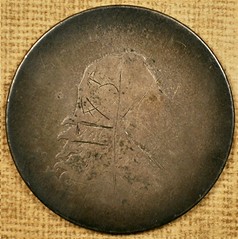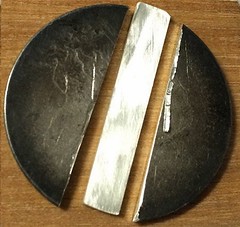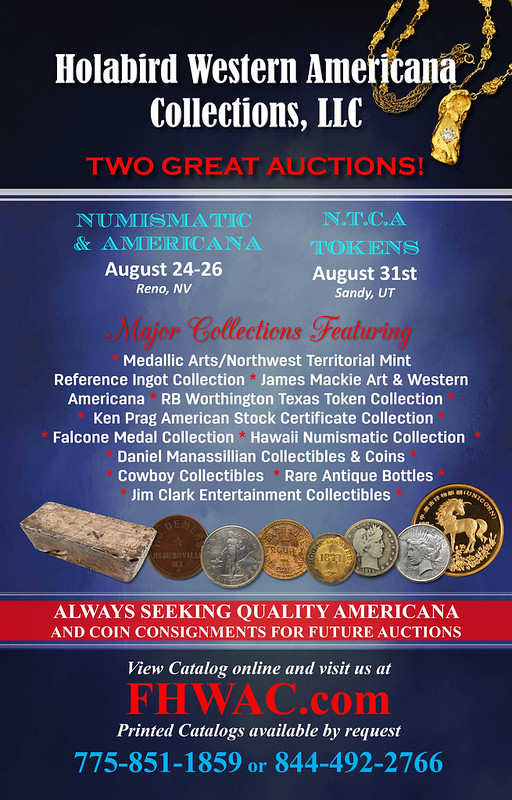
PREV ARTICLE
NEXT ARTICLE
FULL ISSUE
PREV FULL ISSUE
RESEARCHERS PUT EARLY SILVER COINS TO NEW TESTSNewman Numismatic Portal Project Coordinator Len Augsburger provided the following report about new research sponsored by the Eric P. Newman Numismatic Education Society (EPNNES). Thanks. -Editor Early U.S. Mint Research Sponsored by Eric P. Newman Numismatic Education Society   Before and after pictures of a 1795 O-105 Half Dollar. The center piece in the after picture was sent for ICP-AES analysis. At the John Reich Collectors Society meeting held August 15 at the ANA convention in Philadelphia, researchers David Finkelstein and Chris Pilliod presented preliminary results on composition testing of United States 1794 and 1795 coinage. At issue was the question of whether David Rittenhouse, Mint Director, sanctioned the manufacture of silver coinage outside the legal standard. The Mint Act of 1792 mandated an 89.24% standard, but Albion Cox, the melter and refiner, recommended a 90% standard, as coinage with a higher proportion of copper tended to turn black. Interestingly, the annual assay tests of 1795 and 1796 (for coinage for 1794 and 1795, respectively) are unrecorded in the archives. Finkelstein and Pilliod noted the shortcomings of XRF (X-ray fluorescence) testing, which supplies data that is only "skin deep" – about ten microns below the surface. Instead, they arranged for ICP-AES (inductively coupled plasma atomic emission spectroscopy) testing of cut coinage samples. Quoting from Wikipedia, ICP-AES "is an analytical technique used for the detection of chemical elements. It is a type of emission spectroscopy that uses the inductively coupled plasma to produce excited atoms and ions that emit electromagnetic radiation at wavelengths characteristic of a particular element. It is a flame technique with a flame temperature in a range from 6000 to 10000 K. The intensity of this emission is indicative of the concentration of the element within the sample." Pilliod and Finkelstein tested eight silver pieces (one 1794 half dollar and seven 1795 half dollars). Due to the value of the coins, low grade and problem pieces were selected for destructive testing. The 1794 was particularly worn, what Sheldon would have called "basal state," and was donated by the Terry Brand estate, which recently sold a large group of 1794 half dollars through Heritage Auctions. The Eric P. Newman Numismatic Education Society (EPNNES) sponsored the acquisition of other coins. Each piece was sliced into three sections and polished, resulting in small mirrorlike fragments that were then subjected to ICP-AES. Complete statistical analysis is not complete, but preliminary results suggest that, with a high degree of confidence, 1795 silver coinage was indeed struck to a higher standard than that required by law. Chris Pilliod and David Finkelstein will publish full results in due course, and we look forward to studying the complete findings. Mint Director David Rittenhouse was a careful, precise, and rigorous scientist, and, and David Finkelstein likes to say, "there are no coincidences" in numismatic research.  Wayne Homren, Editor The Numismatic Bibliomania Society is a non-profit organization promoting numismatic literature. See our web site at coinbooks.org. To submit items for publication in The E-Sylum, write to the Editor at this address: whomren@gmail.com To subscribe go to: https://my.binhost.com/lists/listinfo/esylum All Rights Reserved. NBS Home Page Contact the NBS webmaster 
|